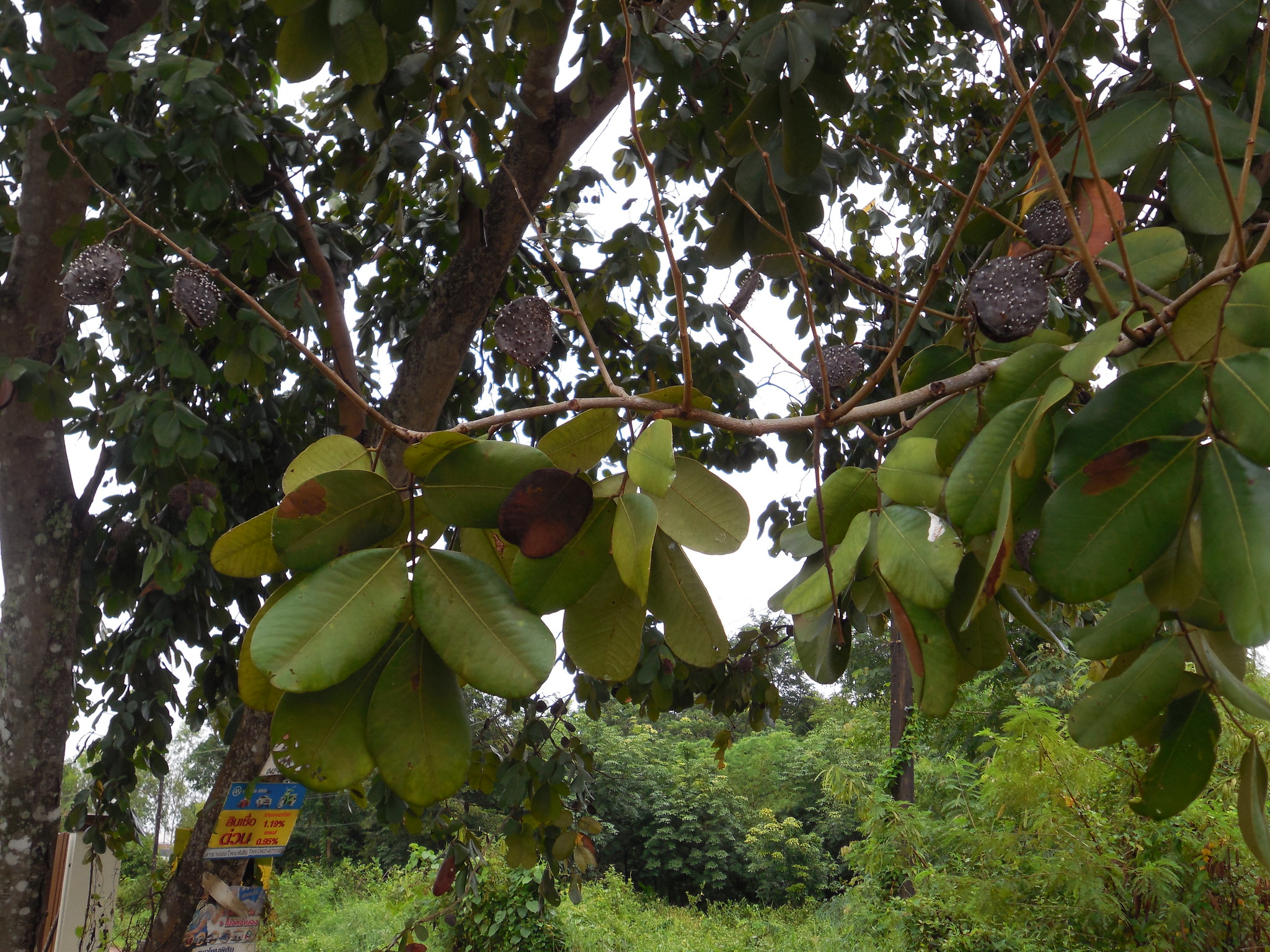ເລກລຳດັບທີ: 569
ລະດັບການຮວບຮວມຂໍ້ມູນ: ຂໍ້ມູນພື້ນຖານ
ປັບປູງຄັ້ງລ່າສຸດ: N/A
ໄມ້ແຕ້ຮໍ້
Mai Tea Nam
Sindora siamensis Teijsm. ex Miq.
ພືດ
ໄມ້ຢືນຕົ້ນ
ຕົ້ນໄມ້ ແລະ ປາມ
×
ຊື່ທ້ອງຖີ່ນ:
Malaysia: sepetir mempelas (Peninsular)
Cambodia: krâkâh'
Laos: têtê 'hoho
Thailand: makha-tae (general), makha-nam (central), makha-yum (northern)
Vietnamese name is gụ mật ( Malaysia: sepetir mempelas (Peninsular)
Cambodia: krâkâh'
Laos: têtê 'hoho
Thailand: makha-tae (general), makha-nam (central), makha-yum (northern)
Vietnamese name is gụ mật)
ຊື່ພ້ອງ
:
Galedupa cochinchinensis (Baill.) Prain
Galedupa siamensis (Teijsm.) Prain
Sindora cochinchinensis Baill.
Sindora siamensis var. siamensis
Sindora wallichii var. siamensis (Teijsm.) Baker
Galedupa siamensis (Teijsm.) Prain
Sindora cochinchinensis Baill.
Sindora siamensis var. siamensis
Sindora wallichii var. siamensis (Teijsm.) Baker
ຊື່ສະກຸນ:
Fabaceae
ຊະນິດໃກ້ຄຽງ:
ບັນຍາຍລັກສະນະທາງພືດສາດ:
ເປັນໄມ້ຢືນຕົ້ນ ໃບລົ່ນຕາມລະດູການ ຫຼື ໃບຂຽວເຄິ່ງປີ, ສູງ 25 ແມດ. ລຳຕົ້ນຊື່, ເປືອກມີສີນ້ຳຕານແກ່, ກ້ຽງ ຫຼື ມີຮອຍແຕກເລັກນ້ອຍ. ກິ່ງງ່າກົມມົນ, ກ້ຽງບໍ່ມີຂົນ. ມີທາດແຫຼວລະບາຍອອກເປັນນ້ຳມັນ ຈັບນຳໝາກ. ໃບປະກອບ, ແບບຂົນນົກປາຍຄູ່, ຈັບສະຫລັບ ແລະ ກ້ຽວວຽນ, ບິ້ງໃບ ຮູບໄຂ່ຫາຮູບຮີ, 2-3 ຄູ່, ປາຍແຫຼມເປັນຕິ່ງ ຫາ ມົນ, ກົກໃບມົນ, ຂອບໃບລຽບ. ກ່າງກາງ ຮາບ ພຽງ ຢູ່ດ້ານເທິງ, ກ່າງຂັ້ນສອງສະຫຼຽງໃຫ້ກ່າງກາງ, ຂະໜານກັນຫ່າງໆ, ກ່າງຂັ້ນສາມຈັດເປັນຕາໜ່າງ. ກ່າງຄູ່ຕ່ຳສຸດ ມີຕ່ອມນ້ອຍໆຄູ່ໜິ່ງ. ຫູໃບກົ່ງໂຄ້ງ ແລະ ຕົກລົ່ນງ່າຍ. ດອກມີຈຳນວນຫຼາຍ ຈັດລຽງຕາມຊໍ່ດອກ ອອກຢູ່ປາຍຍອດ ຫຼື ປາຍງ່າມ, ດອກມີສອງເພດ, ກ້ານດອກຍ່ອຍຍາວກວ່າ 0.5 ຊ.ມ. ໝາກມີຂະໜາດຍາວເຖິງ 8 ຊມ, ເນື້ອແຂງ, ແປ, ມີໜາມ, ມີນ້ຳຢາງຍອ້ຍ ອອກມາຕາມປາຍທີ່ເປັນໂຄ້ງ. ມີແກ່ນ 1 ຫາ 3 ເມັດ.(ຂໍ້ມູນຈາກ ໂຄງການໄບໂອຕິກ)
ນິເວດວິທະຍາ
ເຂດກະຈາຍພັນທົ່ວໂລກ:
N/A
ເຂດກະຈາຍພັນໃນລາວ
:
ທົ່ງພຽງວຽງຈັນ
ເຂດສາຍພູຫຼວງພາກເໜືອ
ເຂດລຽບແມ່ນ້ຳຂອງພາກໃຕ້
ເຂດສາຍພູຫຼວງພາກເໜືອ
ເຂດລຽບແມ່ນ້ຳຂອງພາກໃຕ້

ເຂດກະຈາຍພັນຕາມພູມສັນຖານ
:
ສະເພາະຖິ່ນໃນລາວ:
N/A
ຮຸກຮານ
:
N/A
ສະຖານະພາບການອະນູຮັກ IUCN
:
ມີຄວາມສ່ຽງໜ້ອຍສຸດ
ສະຖານະພາບການອະນຸຮັກແຫ່ງຊາດລາວ
:
N/A
ການນຳໃຊ້
ປະເພດການນຳໃຊ້:
ສິ່ງປູກສ້າງ
ບັນຍາຍການນຳໃຊ້:
ໄມ້ໃຊ້ສຳຫຼັບສ້າງເຮືອນຊານ, ເຮັດເສົາ, ເຟີນິເຈີ, ໂຄງສ້າງອື່ນໆ ແລະ ໄມ້ຟືນ. ເປືອກໄມ້ໃຊ້ເຮັດຝາເຮືອນ, ນ້ຳມັນຈາກເນື້ອໄມ້ຢາເຮືອ ແລະ ເປືອກຫຸ້ມແກ່ນໃຊ້ປົນກັບໝາກກັບພູເພື່ອຄ້ຽວໝາກ, ບາງຄັ້ງກໍ່ໃຫ້ແກ່ນເພື່ອຕົ້ມເປັນເຄື່ອງດື່ມຄືຊາ ແລະ ເປັນສ່ວນປະສົມຂອງຫວານ, ເປືອກເປັນແຫຼ່ງຂອງທາດທານິນ ແລະ ສາມາດໃຊ້ໃນຍ້ອມຕາມໜ່າງ ຫຼື ອວນປາ. ເນື້ອໄມ້ແຂງສີນ້ຳຕານ ຫຼື ສີແດງ ແລະ ມີຈຸດສີດຳ. ມອກໄມ້ເປັນສີເທົາປົນສີນ້ຳຕານ, ມັນເນື້ອໄມ້ທີດີ, ສາມາດແປຮູບໄດ້ງ່າຍ ແລະ ມີຄວາມສວຍງາມ. ນອກຈາກນີ້ມັນຍັງທົນຕໍ່ສະພາບແວດລ້ອມສາມາດໃຊ້ໄດ້ດົນ.
ການປູກ ການລ້ຽງ:
N/A
ລະດູການເກັບກູ້:
ການຕະຫຼາດ ແລະ ຕ່ອງໂສ້ມູນຄ່າ:
N/A
ການຄຸ້ມຄອງຈັດການ
N/A
ໂພຊະນາການ
ຄຸນຄ່າທາງໂພຊະນາການ:
ບັນຍາຍຄຸນຄ່າທາງໂພຊະນາການ:
N/A
| ສານອາຫານ | /100g | ໝາຍເຫດ |
|---|---|---|
| ໂປຣຕີນ | N/A | N/A |
| ຄາໂບໄຮເດຣດ | N/A | N/A |
| ໄຂມັນ | N/A | N/A |
| ວິຕາມິນ | N/A | N/A |
| ແຮ່ທາດ | N/A | N/A |
| ເສັ້ນໄຍ | N/A | N/A |
ອ້າງອິງ
ເຄດິດຮູບພາບ:
ອ້າງອິງ:
Digital Compendium of Forestry Species of Cambodia. www.digitalspecies.blogspot.com; Phnom Penh. http://www.digitalspecies.blogspot.com
Hoang Van Sam, Khamseng Nanthavong & P.J.A. Keßler. 2004. Trees of Laos and Vietnam. Blumea 49: 201--349.
World Conservation Monitoring Centre. 1998. Sindora siamensis. The IUCN Red List of Threatened Species 1998: e.T33242A9770793. http://dx.doi.org/10.2305/IUCN.UK.1998.RLTS.T33242A9770793.en
Hoang Van Sam, Khamseng Nanthavong & P.J.A. Keßler. 2004. Trees of Laos and Vietnam. Blumea 49: 201-349.
Kai Larsen; Supee Saksuwan Larsen; Jules E Vidal. 1984. Leguminosae - Caesalpinioideae in Flora of Thailand. Vol. 4, part 1. Forest Herbarium, Royal Forest Dept. Bangkok.
Hoang Van Sam, Khamseng Nanthavong & P.J.A. Keßler. 2004. Trees of Laos and Vietnam. Blumea 49: 201--349.
World Conservation Monitoring Centre. 1998. Sindora siamensis. The IUCN Red List of Threatened Species 1998: e.T33242A9770793. http://dx.doi.org/10.2305/IUCN.UK.1998.RLTS.T33242A9770793.en
Hoang Van Sam, Khamseng Nanthavong & P.J.A. Keßler. 2004. Trees of Laos and Vietnam. Blumea 49: 201-349.
Kai Larsen; Supee Saksuwan Larsen; Jules E Vidal. 1984. Leguminosae - Caesalpinioideae in Flora of Thailand. Vol. 4, part 1. Forest Herbarium, Royal Forest Dept. Bangkok.
ຜູ້ສ້າງ Factsheet:
ຜູ້ກວດສອບ Factsheet:
,
